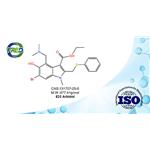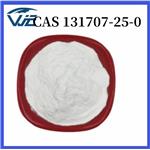Arbidol: History, Pharmacokinetics and Toxicity
Apr 8,2024
General Description
Arbidol, developed around 40 years ago by Russian scientists, is a promising antiviral drug used in Russia and China to prevent and treat respiratory diseases caused by influenza and other viruses. Clinical studies have demonstrated its efficacy in reducing febrile periods associated with viral infections. Arbidol's pharmacokinetics reveal dose-dependent absorption, metabolism by key enzymes like UDP-glucuronosyl-transferase 1A9, and the presence of active metabolites contributing to its pharmacological activities. Despite its low toxicity and good tolerability in short-term use, further research is needed to understand its long-term effects, especially in chronic infection scenarios, to optimize its therapeutic potential and safety profile.

Figure 1. Arbidol
History
Arbidol is a small indole derivative developed around 40 years ago by a collaboration of Russian scientists from various research institutes. The chemical synthesis of Arbidol was first described in 1993 and later modified in 1994. The drug is produced by Masterlek™ in Moscow, a subsidiary of the Pharmstandard Group, as well as by Shijiazhuang No.4 Pharmaceutical™ in China. Arbidol has been on the market for two decades in Russia and has been used in China since 2006 for preventing and treating pulmonary diseases caused by influenza A and B viruses, as well as other respiratory viruses. It has also been utilized to prevent flu epidemics in poultry in China. Clinical studies conducted in the 1990s initially demonstrated the efficacy of Arbidol in groups affected by influenza outbreaks and acute respiratory diseases. Subsequent research in servicemen further supported the drug's effectiveness in reducing febrile periods associated with acute respiratory viral infections. The duration of Arbidol treatment typically ranges from 5 to 20 days, depending on the specific condition being treated. Overall, Arbidol has shown promise in both prophylactic and therapeutic applications against various respiratory viruses, garnering attention for its potential in combating infectious diseases. Further research and clinical trials continue to explore the full scope of Arbidol's benefits and applications in the field of antiviral therapy. 1
Pharmacokinetics
Arbidol, an indole derivative, exhibits poor solubility in aqueous media, impacting its bioavailability, administration forms, and pharmacokinetics. Efforts to enhance its solubility led to the development of ARB-acrylamide polymer complexes with maintained antiviral properties and improved pharmacological index compared to the parent molecule. Arbidol is soluble in hot glycerol and can be diluted for administration in vitro or in vivo. Pharmacokinetic studies in rats revealed comparable plasma elimination half-lives and maximum concentrations for oral and intravenous doses, indicating dose-dependent absorption. High-pressure liquid chromatography facilitated accurate detection of Arbidol in human plasma, confirming minimal interference with expected metabolites. Metabolism studies in humans and rats identified various metabolites, including sulfone and sulfoxide forms, glucuronides, and sulfate conjugates. Liver microsome experiments highlighted UDP-glucuronosyl-transferase 1A9 as a key enzyme in Arbidol metabolism, with potential implications for drug interactions. Notably, Arbidol metabolites exhibit longer elimination half-lives than ARB itself, suggesting greater exposure and possible accumulation with repeated dosing. In vitro data suggested that metabolites like sulfinyl-ARB and sulfonyl-ARB may contribute to Arbidol's pharmacological activities, potentially impacting efficacy and duration of action. However, studies on hepatotropic viruses indicated varying antiviral activities of Arbidol metabolites, with some showing only moderate effects. Further research is needed to elucidate the role of metabolites in Arbidol efficacy and safety, considering their significant plasma exposure and prolonged elimination. Understanding metabolite stability, tissue distribution, and binding properties will be crucial for optimizing ARB's therapeutic potential. 2
Toxicity
Arbidol demonstrates relatively low toxicity levels based on available research findings. Acute toxicity studies in animals show oral LD50 values ranging from 340 to 400 mg/kg in mice, and over 3000 mg/kg in rats and guinea pigs. Intravenous administration resulted in lower LD50 values of 109 mg/kg in mice and 140 mg/kg in rats. Long-term oral administration of Arbidol at varying doses did not lead to pathological changes in animals, indicating good tolerability. Studies in pregnant rats and healthy human volunteers further suggest Arbidol's favorable safety profile, with excellent tolerability reported in short-term use. However, the long-term effects of Arbidol administration, especially in chronic infection scenarios, remain unexplored. 1
Reference
1. Blaising J, Polyak SJ, Pécheur EI. Arbidol as a broad-spectrum antiviral: an update. Antiviral Res. 2014; 107: 84-94.
2. Deng P, Zhong D, Yu K, Zhang Y, Wang T, Chen X. Pharmacokinetics, metabolism, and excretion of the antiviral drug arbidol in humans. Antimicrob Agents Chemother. 2013; 57(4): 1743-1755.
- Related articles
- Related Qustion
- Arbidol: mechanism of action, clinical applications and safety Nov 14, 2023
Arbidol is a broad-spectrum antiviral drug that inhibits virus replication and entry, showing efficacy against respiratory viral infections with a good safety profile.
- New coronavirus drug-Arbidol Nov 1, 2021
Arbidol is suitable for adults and children with influenza A, influenza B, acute viral respiratory infections, severe acute respiratory syndrome, including the prevention and treatment of complicated bronchitis and pneumonia.
Josamycin, a macrolide antibiotic, inhibits bacterial protein synthesis and is effective against various infections due to its unique pharmacokinetic profile.....
Apr 8,2024APIGinsenoside Rg3 exhibits potent anti-cancer effects by inducing apoptosis, inhibiting proliferation, and demonstrating significant anti-angiogenic properties.....
Apr 8,2024APIArbidol
131707-25-0You may like
- Arbidol
-

- $0.00 / 1kg
- 2024-05-09
- CAS:131707-25-0
- Min. Order: 1kg
- Purity: 99%HPLC
- Supply Ability: 20 tons
- Umifenovir
-

- $80.00 / 1KG
- 2023-08-16
- CAS:131707-25-0
- Min. Order: 1KG
- Purity: >99%
- Supply Ability: 20tons
- Arbidol
-

- $48.00 / 1KG
- 2023-05-04
- CAS:131707-25-0
- Min. Order: 1公斤
- Purity: 99%
- Supply Ability: 200tons




